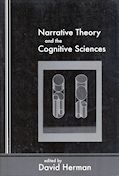David Herman, ed.
Narrative Theory and the Cognitive Sciences.
CSLI. 2003
The problem is this.
We understand the world through narrative (allegedly).
Complex systems are unnarratable (so it seems).
Therefore, we literally cannot understand complex systems.
Since most of today’s big problems are complex systems (climate, poverty, disease, what have you), this is a bit of a snag.
A small group of us are working on a research programme called Narrating Complexity;
this book provides some background reading for me from the narrative cognition side of the coin.
I haven’t read all of the book, only those chapters that seem immediately relevant to the Narrating Complexity programme
(plus a fourth one, as the train was slower that I was expecting).
But the chapters I have read are very good, and my ranking is based on these;
the book is by no means “unfinishable” according to my classification, it is simply “unfinished”.
Abbott discusses why complex emergent systems may be unnarratable.
Turner’s idea of blends compressing down to the human scale might give a hint towards a solution to this.
Some system, rather than being a “mere heap”, is being conceptualised as an entity, albeit maybe not with an agency that we would recognise.
Herman shows why we need to be able to do this.
And Jahn provides the beginnings of a proto-computational model of how parts of the story formation may occur.
Mark Turner. Double-scope Stories.
Humans can recall or imagine stories that run counter to the events we are experiencing, and not get confused by this.
We can take a story, and blend it with a real event, to provide new meaning.
And we can take two distinct stories, possibly with clashing structures, and blend those,
to get a new “double-scope” blended story with its own emergent structures, allowing us to generate novel ideas and concepts.
We can continue doing this, until stories have many levels of blended complexity.
One of the things such blending can do is compress expansive conceptual structures down to human scale, where we can grasp them.
Turner dissects several examples, including: a scene from the 17th century French play Phèdre;
a concept such as punishment that is derived from a blend;
the Old English poem The Dream of the Rood that has many levels of blending;
and even a children’s story that has several sequential blends, and may be thought of as teaching the concept of blending.
H. Porter Abbott. Unnarratable Knowledge: The Difficulty of Understanding Evolution by Natural Selection.
We understand the world through explanatory narratives of entities with agency.
Parts of the world that do not have suitable structure are unnarratable, and hence are not easily understood.
Evolution is one such process.
Neither natural selection nor species have agency, nor are narrative entities.
Such processes have two levels:
the lower level of swarms of interacting individually-narratable individuals,
and the higher level of emergent collective systems that are more than the sum of their individual parts, without narratable agency.
Non-scientific forms of explanation, that specifically invent entities with the agency to guide or control the higher levels,
have much greater narrative power, and so can find readier acceptance among the public.
It may be that complex systems are fundamentally unnarratable:
“There isn’t a story. It’s more like tending a garden, only you’re growing it with 10,000 other gardeners.”
David Herman. Stories as a Tool for Thinking.
Narrative can have many cognitive functions.
It is a system for structuring patterns of events progressing through time: for structuring processes.
It can be used to “chunk” experiences into “frames” of stereotypical experiences,
then used to compare this typical against the actual.
This helps us to understand the world more, and therefore have to memorise less.
It allows us to generate and evaluate what-if scenarios.
It allows us to draw coherent system boundaries:
to extract and bound a relevant collection of participants, events, and structures from the overall stream of events we experience.
By requiring a “beginning” and “middle” and an “ending”,
it allows us to draw temporal system boundaries, and provides a resource for closure.
It allows us to conceptualise causal relationships.
And it provides a means for people to think together.
Manfred Jahn. Awake! Open your eyes! The Cognitive Logic of External and Internal Stories.
This chapter investigates the difference between external stories (a narrated tale)
v internal stories (such as a dream or imagining).
However, this apparently simple partition becomes fragmented on deeper investigation,
as stories go through several stages of external and internal forms as they develop:
they are narrated, heard, internalised, modified, re-narrated, and so on.
This leads to a new cyclical model of stories, with a computational flavour.
For all my book reviews, see
my main website.

No comments:
Post a Comment